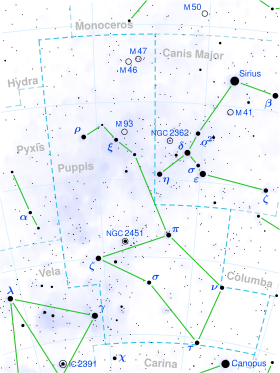
| |
| Observation data Epoch J2000 Equinox J2000 | |
|---|---|
| Constellation | Puppis |
| Right ascension | 07 53 03.63538 |
| Declination | −49° 36′ 46.9530″ |
| Apparent magnitude (V) | 4.63 |
| Characteristics | |
| Spectral type | B2V |
| U−B color index | −0.92 |
| B−V color index | −0.23 |
| Variable type | Constant |
| Astrometry | |
| Radial velocity (Rv) | +8.00±4.2 km/s |
| Proper motion (μ) | RA: −7.77 mas/yr Dec.: +15.16 mas/yr |
| Parallax (π) | 4.30 ± 0.15 mas |
| Distance | 760 ± 30 ly (233 ± 8 pc) |
| Absolute magnitude (MV) | −2.2±0.1 |
| Details | |
| Mass | 9.6 M☉ 10.1±0.5 M☉ |
| Radius | 4.5±0.7 R☉ |
| Luminosity | 5,908 L☉ |
| Surface gravity (log g) | 4.01±0.09 cgs |
| Temperature | 23,700 K |
| Metallicity | +0.01 dex |
| Rotation | 1.33026 d |
| Rotational velocity (v sin i) | 160 km/s |
| Age | 12.6+7.4 −2.7 Myr |
| Other designations | |
| CD−49°3137, CPD−49°1398, GC 10686, HD 64740, HIP 38500, HR 3089, SAO 219106, GSC 08143-03240 | |
| Database references | |
| SIMBAD | data |
HD 64740 is a single star in the southern constellation Puppis, positioned near the line of sight to the Gum Nebula. It has a blue-white hue and is faintly visible to the naked eye with an apparent visual magnitude of 4.63. Parallax measurements give a distance estimate of approximately 760 light-years from the Sun, and it is drifting further away with a radial velocity of +8 km/s.
This is a massive B-type main-sequence star with a stellar classification of B2V. It is a magnetic chemically peculiar star of the helium strong variety with weak hydrogen alpha emission. The polar magnetic field strength is 3,700 G. The star is about halfway through its main sequence lifetime with an estimated age of ~13 million years. It is spinning rapidly with an equatorial velocity of about 140±10 km/s, based on a polar inclination angle of 36°±15°, giving it a rotation period of ~1.33 days. The star is radiating over 5,900 times the luminosity of the Sun from its photosphere at an effective temperature of 23,700 K.
Significant X-ray emission has been detected originating from this star, which may be connected to the magnetically-confined stellar wind. The star does not display pulsation behavior, but it does show a magnetically-modulated variation from the wind. Variation of ultraviolet lines of silicon has been detected, which may be due to surface abundance variations. Two patches of helium overabundance are observed near the magnetic poles, which are inclined by about 20° to the star's pole of rotation.
References
- ^ Van Leeuwen, F. (2007). "Validation of the new Hipparcos reduction". Astronomy and Astrophysics. 474 (2): 653–664. arXiv:0708.1752. Bibcode:2007A&A...474..653V. doi:10.1051/0004-6361:20078357. S2CID 18759600. Vizier catalog entry
- ^ Ducati, J. R. (2002). "VizieR Online Data Catalog: Catalogue of Stellar Photometry in Johnson's 11-color system". CDS/ADC Collection of Electronic Catalogues. 2237. Bibcode:2002yCat.2237....0D.
- ^ Houk, Nancy (1978). Michigan catalogue of two-dimensional spectral types for the HD stars. Vol. 2. Ann Arbor: Dept. of Astronomy, University of Michigan. Bibcode:1978mcts.book.....H.
- ^ Krtička, J.; et al. (August 2013). "Ultraviolet and visual flux and line variations of one of the least variable Bp stars HD 64740". Astronomy & Astrophysics. 556: 11. arXiv:1306.2458. Bibcode:2013A&A...556A..18K. doi:10.1051/0004-6361/201221018. S2CID 73647737. A18.
- ^ Gontcharov, G. A. (2006). "Pulkovo Compilation of Radial Velocities for 35 495 Hipparcos stars in a common system". Astronomy Letters. 32 (11): 759–771. arXiv:1606.08053. Bibcode:2006AstL...32..759G. doi:10.1134/S1063773706110065. S2CID 119231169.
- ^ Shultz, M. E.; et al. (May 2019). "The magnetic early B-type Stars II: stellar atmospheric parameters in the era of Gaia". Monthly Notices of the Royal Astronomical Society. 485 (2): 1508–1527. arXiv:1902.02713. Bibcode:2019MNRAS.485.1508S. doi:10.1093/mnras/stz416.
- Tetzlaff, N.; et al. (2011). "A catalogue of young runaway Hipparcos stars within 3 kpc from the Sun". Monthly Notices of the Royal Astronomical Society. 410 (1): 190–200. arXiv:1007.4883. Bibcode:2011MNRAS.410..190T. doi:10.1111/j.1365-2966.2010.17434.x. S2CID 118629873. Vizier catalog entry
- ^ Shultz, M. E.; et al. (November 2019). "The magnetic early B-type stars - III. A main-sequence magnetic, rotational, and magnetospheric biography". Monthly Notices of the Royal Astronomical Society. 490 (1): 274–295. arXiv:1909.02530. Bibcode:2019MNRAS.490..274S. doi:10.1093/mnras/stz2551.
- ^ Hohle, M. M.; et al. (2010). "Masses and luminosities of O- and B-type stars and red supergiants". Astronomische Nachrichten. 331 (4): 349. arXiv:1003.2335. Bibcode:2010AN....331..349H. doi:10.1002/asna.200911355. S2CID 111387483. Vizier catalog entry
- Gontcharov, G. A. (2012). "Dependence of kinematics on the age of stars in the solar neighborhood". Astronomy Letters. 38 (12): 771–782. arXiv:1606.08814. Bibcode:2012AstL...38..771G. doi:10.1134/S1063773712120031. S2CID 118345778. Vizier catalog entry
- ^ Alecian, E.; et al. (December 2012). Boissier, S.; et al. (eds.). The Magnetism in Massive Stars (MiMeS) project: First HARPSpol discoveries. Proceedings of the Annual meeting of the French Society of Astronomy and Astrophysics. pp. 401–404. arXiv:1211.1075. Bibcode:2012sf2a.conf..401A.
- Hoffleit, D.; Warren, W. H. (1995). "Bright Star Catalogue". VizieR On-line Data Catalog: V/50. Originally Published in: 1964BS....C......0H. 5050 (5th Revised ed.). Bibcode:1995yCat.5050....0H.
- Chini, R.; et al. (2012). "A spectroscopic survey on the multiplicity of high-mass stars". Monthly Notices of the Royal Astronomical Society. 424 (3): 1925. arXiv:1205.5238. Bibcode:2012MNRAS.424.1925C. doi:10.1111/j.1365-2966.2012.21317.x. S2CID 119120749.
- Nazé, Yaël; et al. (November 2014). "X-Ray Emission from Magnetic Massive Stars". The Astrophysical Journal Supplement. 215 (1): 20. arXiv:1409.1690. Bibcode:2014ApJS..215...10N. doi:10.1088/0067-0049/215/1/10. S2CID 54074229. 10.
- Telting, J. H.; et al. (2006). "A high-resolution spectroscopy survey of β Cephei pulsations in bright stars". Astronomy and Astrophysics. 452 (3): 945. Bibcode:2006A&A...452..945T. doi:10.1051/0004-6361:20054730. hdl:2066/36162.